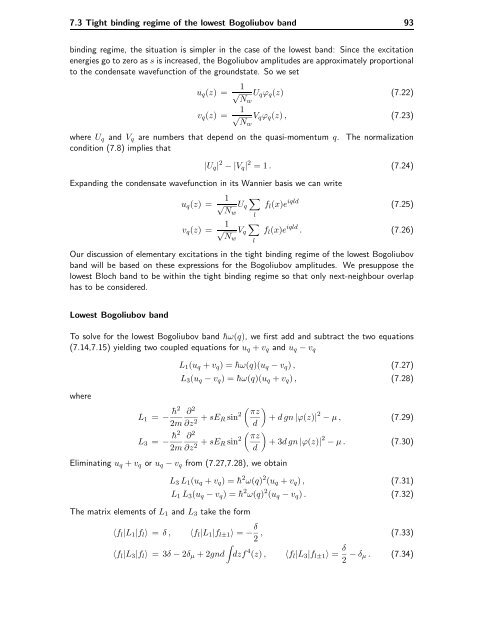Bose-Einstein Condensates in Rotating Traps and Optical ... - BEC
Bose-Einstein Condensates in Rotating Traps and Optical ... - BEC
Bose-Einstein Condensates in Rotating Traps and Optical ... - BEC
You also want an ePaper? Increase the reach of your titles
YUMPU automatically turns print PDFs into web optimized ePapers that Google loves.
7.3 Tight b<strong>in</strong>d<strong>in</strong>g regime of the lowest Bogoliubov b<strong>and</strong> 93<br />
b<strong>in</strong>d<strong>in</strong>g regime, the situation is simpler <strong>in</strong> the case of the lowest b<strong>and</strong>: S<strong>in</strong>ce the excitation<br />
energies go to zero as s is <strong>in</strong>creased, the Bogoliubov amplitudes are approximately proportional<br />
to the condensate wavefunction of the groundstate. So we set<br />
uq(z) = 1<br />
√ Uqϕq(z) (7.22)<br />
Nw<br />
vq(z) = 1<br />
√ Vqϕq(z) , (7.23)<br />
Nw<br />
where Uq <strong>and</strong> Vq are numbers that depend on the quasi-momentum q. The normalization<br />
condition (7.8) implies that<br />
|Uq| 2 −|Vq| 2 =1. (7.24)<br />
Exp<strong>and</strong><strong>in</strong>g the condensate wavefunction <strong>in</strong> its Wannier basis we can write<br />
uq(z) = 1 <br />
√ Uq<br />
Nw<br />
l<br />
<br />
fl(x)e iqld<br />
(7.25)<br />
vq(z) = 1<br />
√ Vq fl(x)e<br />
Nw l<br />
iqld . (7.26)<br />
Our discussion of elementary excitations <strong>in</strong> the tight b<strong>in</strong>d<strong>in</strong>g regime of the lowest Bogoliubov<br />
b<strong>and</strong> will be based on these expressions for the Bogoliubov amplitudes. We presuppose the<br />
lowest Bloch b<strong>and</strong> to be with<strong>in</strong> the tight b<strong>in</strong>d<strong>in</strong>g regime so that only next-neighbour overlap<br />
has to be considered.<br />
Lowest Bogoliubov b<strong>and</strong><br />
To solve for the lowest Bogoliubov b<strong>and</strong> ¯hω(q), we first add <strong>and</strong> subtract the two equations<br />
(7.14,7.15) yield<strong>in</strong>g two coupled equations for uq + vq <strong>and</strong> uq − vq<br />
L1(uq + vq) =¯hω(q)(uq − vq) , (7.27)<br />
L3(uq − vq) =¯hω(q)(uq + vq) , (7.28)<br />
where<br />
L1 = − ¯h2 ∂<br />
2m<br />
2<br />
∂z2 + sER s<strong>in</strong> 2<br />
<br />
πz<br />
+ dgn|ϕ(z)|<br />
d<br />
2 − µ, (7.29)<br />
L3 = − ¯h2 ∂<br />
2m<br />
2<br />
∂z2 + sER s<strong>in</strong> 2<br />
<br />
πz<br />
+3dgn|ϕ(z)|<br />
d<br />
2 − µ. (7.30)<br />
Elim<strong>in</strong>at<strong>in</strong>g uq + vq or uq − vq from (7.27,7.28), we obta<strong>in</strong><br />
The matrix elements of L1 <strong>and</strong> L3 take the form<br />
L3 L1(uq + vq) =¯h 2 ω(q) 2 (uq + vq) , (7.31)<br />
L1 L3(uq − vq) =¯h 2 ω(q) 2 (uq − vq) . (7.32)<br />
〈fl|L1|fl〉 = δ, 〈fl|L1|fl±1〉 = − δ<br />
, (7.33)<br />
2<br />
<br />
〈fl|L3|fl〉 =3δ− 2δµ +2gnd dzf 4 (z) , 〈fl|L3|fl±1〉 = δ<br />
2 − δµ . (7.34)




